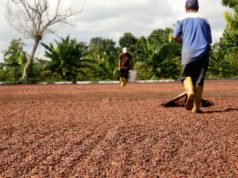By María Ángela Valbuena
Photos: Pixabay.com / Natalia Brand @Gastrobrand / Liliana Elías
Nevertheless the quality of Venezuelan cocoa is recognised worldwide, the consumption of chocolate in the country is one of the lowest in the continent.
According to estimates made by Cesar Guevara, former president of the National Association of Industrial Cocoa Processors (APROCAO), Venezuelans consume between 300 to 350 gr of chocolate per capita a year –what is equivalent to ten Cri Cri chocolates.
This figure places Venezuela together with Colombia up to the seventh position in consumption in Latin America, according to Euromonitornumbers as of December 2016. Mexico takes the sixth place with consumption of 500 gr per person a year, being Peru in the fifth place with 0.7 k per person a year.
Along in line, Argentina, with 0.9 kilos per capita a year, Brazil with 1.4 kilos, Uruguay with 1.6 kilos and Chile at the top of the line with 1.8 kilos

Without cocoa there is no chocolate
There is no doubt at all that consumption figures in Venezuela reflect the serious economic crisis that the country is going through.
A depressed agricultural sector caused by weak government policies, limited transportation means, a lack of spare parts for machinery, and a shortage of raw materials are combined, among other factors, to have the worst cocoa productivity in the world..
At the other end of the marketing chain, chocolate has become a luxury that very few can afford, considering that more than 9.6 million Venezuelans are unable to meet their daily food needs,according to the survey Life Conditions in Venezuela (ENCOVI), 2016.
“The price of a chocolate bar in the local market amazes us. However, we must keep in mind that the price of cocoa beans increased 87% in 2016, “says César Guevara from APROCAO, adding that the drop in consumption that year was over 30%.

Savoy was founded 76 years ago.
With Venezuelan flavour
The Euromonitorstudy remarks that Nestlé is leading the manufacture of chocolates in Venezuela with a 64% share in retail sales, and dominates the square market with 78%, thanks to its commercial relationship with Savoy, founded in 1941, with its iconic products such as Cri Cri. The old squares with almonds, hazelnuts and fruit have been reshaped and now are part of the high-end Carré line.
In addition, chocolates and candies Savoy Nestlé are virtually distributed in any kiosk and grocery store in the country. Thanks to their formulation they are less susceptible to melting or having their organoleptic properties changed.
The second place on sales is held by Chocolates El Rey, which has been able to position its Carenero Superior chocolate line very well, although they are mainly focused on the industrial sector, with products such as coatings for cookies and ice cream, special pastry coating for desserts, bonbons and moulding pieces, chocolate shower and instant chocolate.
Hence, it is very likely that a sweet or ice cream you taste, or a dessert that you consume in a restaurant, or a cup of hot chocolate you drink, is made with Chocolates El Rey.

The most chocolatiers
José Tomás Lyon, director for Mondelez Chile -the second confectionery company in the world- agrees with Euromonitor regarding the country’s leadership in the region, with a slightly higher figure of 2.4 kilos of chocolate per capita a year, as per statements given to the newspaper El Mercurio.
In both cases, the figures place Chile above countries that are also cocoa producers, such as Mexico, Brazil, Colombia and Venezuela as well as others of great chocolate tradition like Argentina and Uruguay. Additionally, this is the country that spends more on this product, for instance, each Chileanspends an average of 30 dollars a year in purchasing chocolates.
Regarding consumer preferences, Lyon points out that local production has focused on milk-based and whole almond-based products. “The industry has grown since people are willing to pay more for a good chocolate,” he says.
While Chileans lead the way in Latin America, they are still far behind countries such as Switzerland, where consumption per person reaches 9 kilos per yearwith an average spending of 255 dollars, according to Euromonitor. It is followed by Germany with 7.9 kilos per year and in third place is England and Ireland with an annual consumption of 7.5 kilos per person.
Worldwide, the consumption of chocolates exceeds 100,000 million dollars and the forecasts say that this market will continue to grow significantly.









A todos los interesados en la historia del cacao y su consumo les recomiendo leer mi trabajo el cultivo del cacao venezolano desde Maruma disponible desde A todos los interesados en la historia del cacao y su consumo les recomiendo leer mi trabajo el cultivo del cacao venezolano desde Maruma disponible desde https://www.researchgate.net/…/295856779_El_cultivo_del…
Comments are closed.